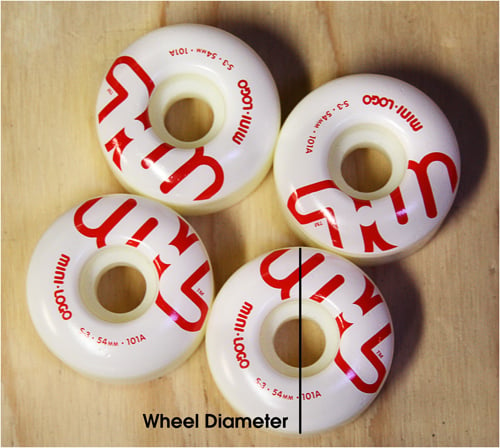Choosing the right size skateboard will help you progress and learn more easily. As you get more experienced, you'll learn what sizing you prefer, until you reach this point, we recommend choosing your deck size base on your shoe size. This will give you a good baseline. Some things to keep in mind, especially if you are choosing between different skateboard deck sizes. A larger or wider deck will be more stable and comfortable for riding, while a smaller or skinnier deck will be more nimble for flip tricks, ledges, and technical skating.
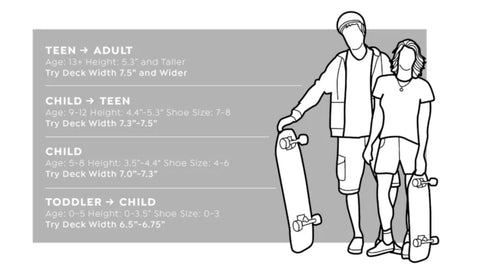
Choosing the width of your skateboard is one of the most important decisions you can make when considering your deck. It will be incredibly important considering what you’ll be using your skateboard for: cruising, street skating or park skating. You could choose based on shoe size and height or you could get down to a trusted skate shop and stand on a bunch of boards to see what feels right.
Sizes for Kids and Beginners
For kids aged 9 and below, we generally recommend a board 7.3 - 7.5 inches wide and anywhere under 30 inches long. You can find these boards in our range of mini decks. Built specifically for the younger skater, these boards are much easier to flip and pop than full size boards.
Sizes for Adults
Most skateboards range between 7.5 and 8.4 inches the most popular being 8 inches. At SkateHut you can shop for skateboard decks with a width size of anywhere between a 7.5 inches and 10.5 inches. These can be bought as single decks, complete skateboards or can be custom built.
The skateboard deck length is not as much of an important factor. Skateboard length can be determined by measuring from the tip of the nose to the tail. Typically skateboard lengths fall between 28 and 33 inches, 71 - 84 cm long. Generally anything under a 31 inch deck will classed as a mini skateboard.
Skateboard Deck Concave

The concave is the curvature of the deck width as you look at it straight on. There are three main types of deck concave: Mellow, Medium and Steep.
-
Mellow concave boards
Mellow concave boards can provide a more stable or comfortable feel under your feet when standing motionless on the deck. However the flatter the concave, the harder it will be to perform flip tricks.
-
Medium concave boards
Standard or medium concave boards are good for beginners. If you don’t know what type of concave to go for, try a medium concave, see how it suits you.
-
Steep concave boards
Steep or high concave boards are raised more at the edge. These boards are great for mastering and performing flips and ollies.
Skateboard Wheels - Completes
Wheel size and durometer is not really something to worry about when buying a complete skateboard - especially for beginners. Most complete skateboards will range between 50mm and 54mm and durometer will mostly range between 97A and 99A. Wheel specification is something a skaterbecomes more concerned about at an intermediate-expert level
Skateboard Trucks - Completes
Again, trucks aren't something to be too concerned with when buying a complete skateboard. However it will be worth noting that on all complete skateboards the trucks are not super tight. Trucks may or may not need to be tightened upon purchase. This will all come down to the weight of the skater. If you are in any doubt about this aspect of the skateboard or would like some advice on trucks. Pop down to your local skate shop or call our friendly support team for help and advice.
Want to build your oren Skateboard? It all starts with the trucks and the Deck!
To build your own custom skateboard these are the necessary components:
- Skateboard Deck
- A set of trucks (2)
- A set of wheels (4)
- A set of beraings (2 per Wheel or 8 Total)
- Hardware (a set of 8 nut and bolt combinations necessary to attach trucks to board)
- Grip Tape(Sand-paper like material on top of skateboard to increase grip)
Optional component:
- Riser Pads depending on diameter of wheel (1 per Truck, 2 Total)

Skate Decks
The skateboard deck refers to the actual board platform on which you will be “shredding”. Skateboard decks are traditionally made of multiple plies of maple wood layered on one another (7 is the average) and this adds to their durability and strength. When beginning the search for a suitable skateboard deck, the width is an important overall characteristic. Different shapes and widths of decks are conducive to varying styles of skateboarding, but in the beginning choosing a deck width slightly narrower than the length of your foot is the best bet.
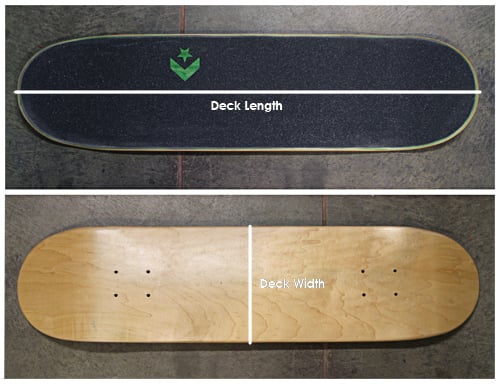 Widths
Widths
The range of average skateboard widths (barring longboards, cruisers, or miniature boards) is from 7.5” to 8.5”. Different styles of skateboarding correspond to certain general widths. Wider boards are more stable, but often more difficult for tricks. Narrower boards are usually more responsive and easier for tricks, but also less stable.
Wheel base
The wheel base is the distance between your mounted trucks and varies based on your body type and personal preference. Like your “stance” in any other board sport, if you have longer legs, you’ll want a wider wheel base. The wheelbase determines the turning radius of the board; a shorter wheelbase will have a shorter turning radius and a longer wheelbase a bigger turning radius.
Concave or Shape
Each manufacturer - and furthermore - various series of boards from vendors feature differing shapes or degrees of concavity. Concave is related to the amount of bending and shaping between the sides of the board, and can affect the ease of performing tricks in numerous ways. Flatter boards with less concave can be better for technical flip tricks, while boards offering increased concave are generally more solid and easy to control.
Trucks
The trucks attach the wheels to the deck and allow for turning and pivoting on the axle. The ease of pivoting on trucks can be adjusted. Tightening the nut on the kingpin compresses the bushings and creates a stiffer feel when turning. Looser trucks are better for turns while tighter trucks are better for pop. Changing the hardness or durometer of the bushings will also change how the trucks will pivot. Trucks come in different widths so it's important to know the size of your board before picking out trucks.
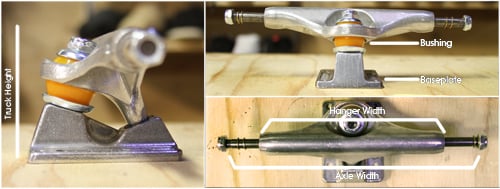
Trucks are available in varying heights and each is better suited for various skateboarding styles and activities. In general, there are LOW, MID, and HIGH truck styles.
Truck Heights
Low - Best suited for flip tricks and providing extra stability, this truck hieght goes well with smaller wheels to reduce chances of “wheel bite." This is also good for beginners because of the lower center of gravity
Mid - Best for skateboarding in the streets or at a park, but very versatile, this truck height is the most common for all-around skateboarding.
High - This height is utilized by skaters mainly interested in cruising or carving and those less focused on flip tricks.
Size or Axle Width
Truck size is determined by the width in inches of the axle (shown in the diagram above). In general, the size of the truck axle should be similar to the width of the skate deck. The majority of trucks are produced to be suitable for most 7.5” to 8” deck sizes.
Bushings
Bushings are rubber pads between the kingpin and the hanger on a truck. There are 2 bushings per truck. Harder bushings are harder to turn on but return more energy giving a springier return to center or more resistance for pumping. Softer bushings absorb energy and impact making turning easier.
Tightening your trucks, via the kingpin nut, can change the way your board performs.
Kingpin
The kingpin is the threaded bolt that holds the bushings to the truck hanger
Wheels
The two main choices in skateboard wheels are diameter (in millimeters) and durometer (hardness).
Wheel Diameter
Wheel diameter, measured in millimeters, is usually printed on the outer surface of the wheel. Different sizes of wheels lend themselves to different styles of skateboarding. The most common range for street and park skating is between 50mm and 60mm, while wheels larger than 60mm are usually used on longboards or cruisers. Smaller wheels (50mm to 54mm) are slower and more prone to getting caught on cracks or rocks, but are preferred by street or technical skaters due to less weight and increased ease for technical tricks. Larger wheels allow the skateboarder to go faster and avoid cracks, but increase weight. Beginners should start with a wheel in the middle of the range, ~54-55 mm.
50-54 mm - Small and slow wheels, but preferred by street or technical skaters due to less weight and increased ease in flipping the board.
54-58 mm - Versatile, allow the skateboarder to ride in various conditions. This is a good range for beginners that do not have a specific preference on wheel size.
>58 mm - Larger, faster wheels, but more practical for longboarding or cruising as tricks may be difficult to pull off due to weight and size.
Durometer
Wheels also vary in their hardness. Wheel durometer, or hardness, is generally rated on a scale called “Durometer A Scale” with hardness ratings from 1-100A, 100A being the hardest. Soft wheels (< 88a) are great for skateboarding around rough surfaces, rolling over cracks and pebbles, and are often found on longboards or cruiser boards that need a lot of grip on concrete surfaces. They aren’t ideal for technical or street skateboarding, as the grip and softness reduces the ability to pop the board off the ground and perform tricks.
Softer Wheels ( <88a to 95a ) are great for skateboarding on rough surfaces, rolling over cracks and pebbles. They aren’t appropriate for technical or street skateboarding, as the grip and softness of the wheel reduces the ability to pop the board off the ground and perform tricks.
Harder Wheels ( 95a to 100a ) are most common for street or technical skateboarding. These wheels have less friction and ride faster. Wheels of this durometer are versatile and work well in the most common skating areas such as street, park, or vert.
Some wheel hardness is measured in Durometer B; wheels using this scale tend to be a lot harder. Refer to the durometer chart for conversion between Durometer A and Durometer B ratings.
| Durometer Comparison Chart |
| A |
B |
| 100 |
85 |
| 95 |
81 |
| 90 |
76 |
| 85 |
71 |
| 80 |
66 |
| 75 |
62 |
Bearings
Bearings are all manufactured in the same size which makes the process of buying bearings simpler - any bearing will fit any wheel. Bearings fit inside the wheels and allow them to spin with less friction and greater speed. Differences in bearings include the quality of construction and the speed rating of the bearings themselves.
Speed Rating or ABEC
Bearings are rated on a speed scale called ABEC (Annular Bearing Engineer's Committee) factor, which classifies the speed of the bearing on a scale of 1,3,5,7, and 9. The higher the ABEC rating of a bearing, the less friction the bearing will experience and the faster the wheel will spin. Higher quality bearings will have sturdier construction, less friction, and often have a higher ABEC rating. Beginners don’t necessarily need more than an ABEC 3 or 5.
Maintenance: Bearing shields keep dirt from getting into the bearing and the ball bearings. Speed cream or lubricant keeps bearings smooth, clean and quiet.
Hardware
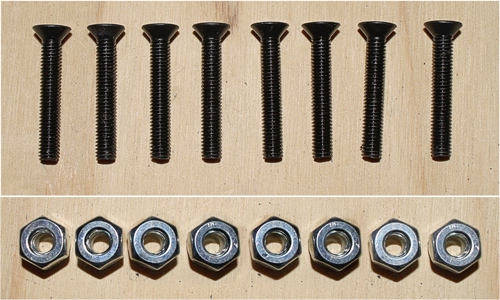
Hardware is necessary to attach the truck assembly to the actual skateboard deck and comes in sets of 8 bolts and 8 nuts. The most common sizes of hardware are 7/8” (for use with no risers) and 1” (for 1/8” risers). These sizes of hardware should be sufficient to assemble most skateboard set-ups. If you're using riser pads with a height larger than 1/8”, then longer hardware sets may be required. Use a 3/8” socket size tool to change hardware.
Grip Tape
Grip tape is the adhesive sandpaper-like material applied to the top of the skateboard deck. Grip tape is necessary to ensure control and grip on the board for the skater. Most grip tape manufacturers make a standardized size and personal preference reigns supreme. You can choose whatever manufacturer or style that works best for you!
Riser Pads
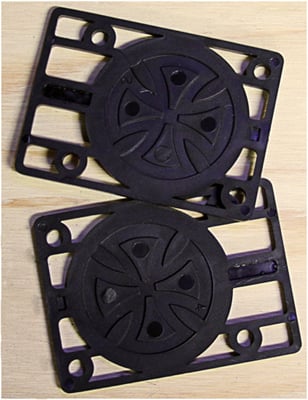
Riser pads are utilized to protect the skater from dreaded “wheel bite” (a nasty situation caused by your wheels contacting the deck of the skateboard and provoking a crash). Not everyone needs riser pads, and if you are rolling around on wheels less than 54mm or 55mm, you should be fine. But riser pads add additional benefits, such as reduced stress on the skateboard deck by distributing pressure efficiently.
Those who ride pools or vert will definitely need riser pads.
Safety Equipment
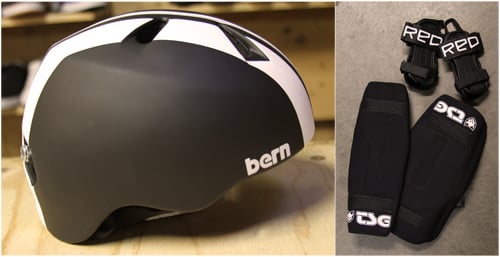
Remember everyone, safety first, and second… and probably third. One of the most important parts of your skateboarding set up will be top-notch safety equipment including Helmets, Knee Pads, Elbow Pads, and Wrist Guards. Properly utilizing safety equipment and knowing how to fall correctly ensures a pain-free and prolonged skateboarding career.





